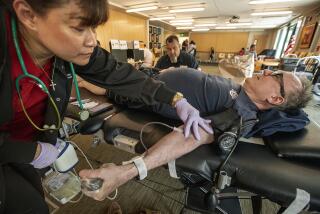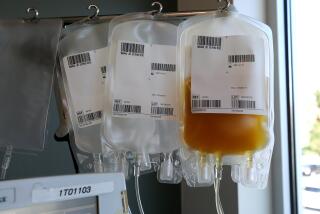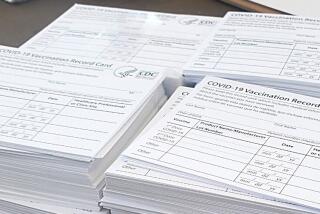Experts Confident Despite Tainted Plasma Donation
Experts expressed a high degree of confidence Tuesday in the safety of the blood supply despite donations by a reputed male prostitute of plasma tainted with the AIDS virus.
Joseph Edward Markowski, 28, was charged Tuesday with attempted murder in part because, according to Dist. Atty. Ira Reiner, Markowski donated blood plasma with the knowledge that he was infected with the AIDS virus and sold plasma at least once at a proprietary blood center in downtown Los Angeles.
But physicians and others familiar with the blood-screening process said there are a number of safeguards to prevent tainted blood from reaching hospital patients. These are not fool-proof, but the probability of detection or destruction of the virus is very high.
All blood products collected at proprietary centers--and at voluntary donor centers as well--by law undergo laboratory testing for the AIDS virus, and blood that tests positive is destroyed. Because the test--like virtually all lab tests--occasionally gives a false result, and because recently infected donors do not test positive for up to three months after infection, there is a slight chance of tainted blood getting through. Red Cross officials estimate that chance as 1 in 64,000.
Use of Products Restricted
However, the law also restricts the use of blood products from centers where donors are paid, such as in the one known instance in which Markowski gave plasma. Unlike plasma donated by volunteer donors at Red Cross or hospital blood centers, plasma that is collected from donors at proprietary centers in California is never transfused directly to patients in its “raw” form, according to Dr. Steven Kleinman, associate medical director at the Los Angeles-Orange County Red Cross Blood Center.
Use in Gamma Globulin
Instead, the paid-donor plasma is sold to pharmaceutical firms for use in gamma globulin, albumin and an anti-clotting factor that is used to control bleeding in hemophiliacs, he said. The process by which the plasma is converted into these products includes a heating procedure that kills the virus.
Plasma is the liquid portion of blood. Other blood elements include red and white cells, which can be transfused into patients.
According to Dr. James Mosley, a USC School of Medicine physician who heads a federally funded transfusion safety study, screening of donors and heat treatment “very greatly” reduce the risk of transmission of the AIDS virus.
‘There Is No Problem’
“For albumin and gamma globulin, I think there is no problem” of a risk of AIDS, he said. “It is the anti-clotting factor concentrate that could be a problem because it can’t be heated as much without destroying its biological effectiveness.”
Nevertheless, the heating process for the anti-clotting factor, which became mandatory in 1983, has greatly reduced the risk of hemophiliacs becoming infected, authorities say.
The Markowski case has drawn renewed public attention to the safety of the blood supply from the AIDS virus, a topic that also was the cause of considerable concern in medical circles in the early 1980s. Before 1985, when a blood test for the presence of antibodies to the AIDS virus became available, blood-collecting agencies had no way to tell whether a donated pint of blood was contaminated with the virus. They were forced to rely solely on the hope that infected people would not try to donate their blood. Although the development of the test has not made blood perfectly safe, it has greatly reduced the risk.
Steps Taken
Les Jacobson, a spokesman for Baxter Travenol, the parent company for Hyland Therapeutics, a laboratory that buys donor-paid plasma and makes it into other products, described in a telephone interview the steps taken to detect tainted blood.
He said all donors undergo a physical exam by a physician at the donor center before plasma is drawn. The purpose is to look for needle marks or enlarged lymph glands that might indicate the individual may be an AIDS carrier. Despite this, Markowski was permitted to donate blood.
A sample of all blood or plasma drawn by the centers is sent to the firm’s Oak Mount, Ill., laboratory for testing for the AIDS virus. If the test is positive, the donor center is notified and the donation is destroyed, he said. If it is negative, the center sends the donation to Baxter Travenol or one of three or four similar companies that operate in the United States.
In order to avoid contamination of the anti-clotting factor or other products, the plasma undergoes the heat and other processes intended to kill the virus.
Security Precaution
Jacobson said donor-paid centers attempt to control people from donating at different centers under different names by requiring them to show their Social Security card. Once a donor has been identified as being a carrier of the virus, his name and Social Security number are listed on a computerized hot-line sheet distributed to all donor-paid centers, he said.
Jim Reilly, the administrative assistant at the American Blood Resources Assn., an organization of donor-paid centers, said there are 415 licensed plasma centers in the United States, including 34 in California. Reilly said they collect 11 million pints of plasma annually.
The procedures followed by the donor-paid centers to protect the blood supply are the same as for the Red Cross and hospital-based volunteer centers, according to Kleinman, the Red Cross official.
The only difference, he said, is whether individuals who go to centers where they are paid for a donation are less truthful about their risk status than those who donate at volunteer centers.
More to Read
Sign up for Essential California
The most important California stories and recommendations in your inbox every morning.
You may occasionally receive promotional content from the Los Angeles Times.










